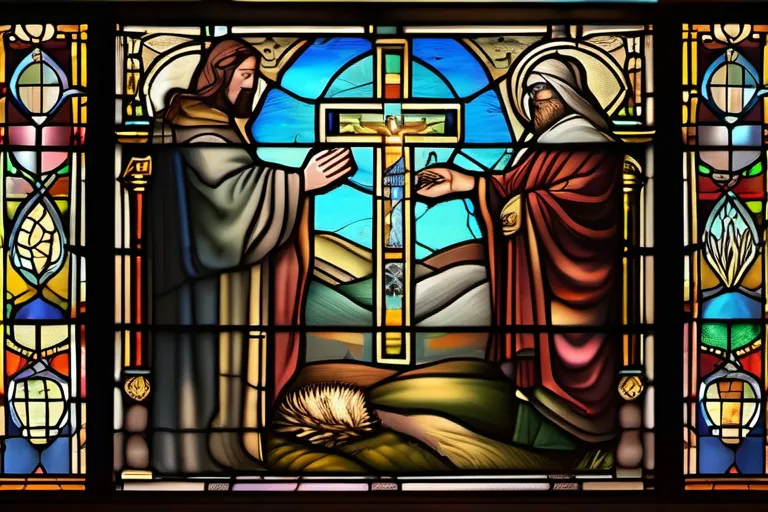Explore how key prophecies, figures, and themes in the Old Testament set the stage for the arrival of Jesus Christ.
The Old Testament plays a crucial role in preparing the way for Jesus in Christianity. This article delves into the significant prophecies, figures, and themes that foreshadowed the coming of Jesus Christ. Let’s embark on this enlightening journey!
The Prophecies of Jesus’ Coming
How do you prepare for a grand event? Much like setting the stage for a big celebration, the Old Testament lays down the groundwork for Jesus’ arrival in a profound and intricate manner. Isaiah 9:6, one of the most famous prophecies, speaks about a child who will be called Wonderful Counselor, Mighty God, Everlasting Father, and Prince of Peace. This verse not only foretells the Messiah but also hints at His multifaceted role – from being a wise advisor to the ultimate ruler of eternity. How many times have we pondered over such divine titles? Could this child be more than just a mere prophet?
Similarly, 2 Samuel 7:14 presents another glimpse into Jesus’ lineage and destiny. This passage promises David’s family an everlasting throne through King Solomon, who is later seen as a figure of Christ in some interpretations. The idea that the throne was not just for Solomon but for his descendants hints at the eternal nature of Jesus’ reign. Could this throne be a symbol of His enduring kingship over all generations?
These prophecies are like threads woven into the fabric of the Old Testament, each one adding to the tapestry that ultimately points towards Christ. They serve as reminders that God’s plan for humanity has been in motion since the very beginning – even before Adam and Eve stepped out of Eden.
Imagine these verses as beacons guiding us through history, lighting up the path from Abraham to Joseph, from Moses leading the Israelites out of Egypt to David establishing his kingdom. Each step, each moment in this long journey, is a piece of the puzzle that culminates in the birth of the Savior. How could anyone miss these clear signals? They are not just words on a page but a divine roadmap to the heart of Christianity.
Key Figures Preparing the Way for Jesus
How did the Old Testament pave the way for Jesus? One compelling answer lies within the roles of key figures like John the Baptist, Abraham, and Moses. Consider this: without these pivotal individuals, would Jesus have been seen as the long-awaited Messiah?
Moses, often seen as a prophetic precursor to Christ, laid down foundational laws and principles that anticipated the coming of the savior. His life was marked by divine intervention and significant miracles. How many times did God step in to save Moses from seemingly insurmountable challenges? The plagues on Egypt, leading the Israelites out of slavery, and even the parting of the Red Sea—these were not mere coincidences but precursors to the ultimate deliverance brought about by Jesus.
Abraham too played a crucial role. Known for his faith and obedience, he was promised descendants who would inherit the world, echoing the eternal promises that were later fulfilled in Christ. The covenant God made with Abraham symbolized the promise of salvation, a concept that found its ultimate fulfillment through the life, death, and resurrection of Jesus.
And then there’s John the Baptist, often called “the voice crying out in the wilderness.” His role was to prepare the way for Christ. By immersing people in water, John symbolically washed away sins, preparing them spiritually for the coming Messiah. Just as a path needs clearing before it can be walked upon, so too did John’s ministry clear the spiritual landscape for Jesus.
Reflect on these figures and their roles: Moses, Abraham, and John the Baptist each served to open doors and pave paths, much like how a skilled architect designs blueprints that guide builders in constructing a magnificent edifice. In this grand narrative of scripture, they were architects, laying the groundwork for the arrival of Jesus, the ultimate fulfillment of all these prophecies and promises.
Themes of Salvation and Redemption
Imagine the Old Testament as a grand symphony, where each note and harmony sets the stage for a climactic finale—the arrival of Jesus Christ. The themes of salvation and redemption run like golden threads throughout this ancient score, intertwining to create a rich tapestry that paves the way for the Messiah’s coming.
From the very beginning, the story of Adam and Eve in Genesis lays down the first chords of a complex melody. The serpent’s temptation and humanity’s fall are not just historical events but a pivotal moment where the idea of redemption is introduced. It’s as if God whispers to us, “There will come a day when I will redeem what was lost.” This theme is echoed in the covenant with Abraham, where God promises an offspring who will bring about salvation (Genesis 12:3). Here we see the promise of a savior, but it remains veiled, like a distant star.
As the narrative progresses through the stories of Isaac, Jacob, and Joseph, these themes continue to unfold. The Exodus story under Moses not only speaks of deliverance from slavery but also foreshadows the ultimate liberation that Jesus will bring. It’s as if God is saying, “I am your liberator, and I have plans for you.” Each character faces trials and tribulations, yet their faith in a greater purpose keeps them hopeful, mirroring the journey of humanity toward redemption.
The prophets then pick up this thread with a urgency that cannot be missed. Isaiah’s vision of a suffering servant who would bear our sins (Isaiah 53) is nothing less than a portrait of Jesus Christ. Jeremiah prophesies about a new covenant, one where God’s law will be written on the heart (Jeremiah 31:31-34), anticipating the Holy Spirit’s work in believers’ hearts today.
These prophecies and themes, woven together like complex patterns in a carpet, gradually build anticipation for the arrival of Jesus. Each prophecy is like a piece of a puzzle that comes into focus only when all are assembled—each pointing to Him as the promised deliverer and savior. The Old Testament becomes not just a record of past events but a living testament, guiding us toward understanding who Christ truly is.
The Messianic King and the Davidic Line
Imagine the Old Testament as a grand tapestry, each thread carefully woven to tell the story of humanity’s quest for salvation. One of the most significant threads is the promise of a Messianic King, born from the line of David—a king who would bring peace and prosperity to his people.
Why is this so crucial? The Davidic line, with its rich history and divine lineage, serves as both a beacon of hope and a prophecy waiting to be fulfilled. Just like a long-lost treasure map leading to buried gold, the promise of a Messiah is embedded in the heart of Israel’s history.
Consider the kingship of David. He was not only a warrior who conquered enemies but also a poet who penned psalms, a man after God’s own heart. The idea that one day there would be another king like David, greater even than him, is a powerful narrative that has captivated generations.
The prophets, through their visions and words, painted a vivid picture of this future king. They spoke of a ruler who would sit on the throne of David forever (see Jeremiah 23:5). This prophecy was a ray of light in the darkness of Israel’s history, offering a promise that even after exile and suffering, there would be redemption.
The significance of this messianic king lies not just in his lineage but in the role he fulfills. He is not only a political leader but also a spiritual savior—someone who will restore everything to its original perfection. This concept is beautifully encapsulated in the idea that one day, “the wolf will live with the lamb” (Isaiah 11:6), symbolizing peace and harmony.
The fulfillment of this promise came with Jesus Christ, who was born into the Davidic line. Through his life, teachings, and ultimate sacrifice on the cross, Jesus embodied the very essence of what a messianic king should be—a king who brings not just political power but spiritual transformation to humanity.
The Suffering Servant and Jesus’ Passion
Imagine the Old Testament as a grand tapestry, woven with threads of prophecy and expectation. One of these threads stands out starkly: the prophecy of the Suffering Servant in Isaiah 53. How does this ancient text prepare us for the arrival of Jesus Christ?
Consider the imagery of a lamb led to slaughter. Is it possible that the writer of Isaiah was hinting at something greater than just animal sacrifice? Could he have been pointing ahead to a future Sufferer, whose life and death would change the course of history?
The prophecy speaks of someone who bears our sins, who is pierced for our transgressions. It describes his suffering as a means of bringing healing to many. These words echo through the centuries, preparing hearts for the personification of these very attributes in Jesus Christ.
Think about it: how could such detailed and somber prophecy be fulfilled by just any man? Yet, when we see Jesus’ life—his humble origins, his ministry among the poor and sick, and finally, his crucifixion—the fulfillment of this prophecy becomes clear. Each part aligns with the narrative painted in Isaiah.
The Suffering Servant’s silence on the cross echoes the obedience of Christ, who submitted to death for our sins. His wounds and bruises are compared to those inflicted by a whip or thorns—exactly what Jesus endured at the hands of Roman soldiers. Even his resurrection from the dead is foretold in these verses, promising new life through his sacrifice.
Could it be that the Old Testament writers, knowing only shadows of the future, were still guided by divine inspiration to prepare us for this monumental event? The prophecy of the Suffering Servant does more than point forward; it explains the profound depth and scope of Jesus’ mission.
Reflect on these words: ‘He was pierced for our transgressions, he was crushed for our iniquities; the punishment that brought us peace was on him, and by his wounds we are healed.’ (Isaiah 53:5) How can such a profound truth prepare us to understand and believe in Jesus?
As we delve into this prophecy, we find not just a shadowy figure but a clear path leading directly to the heart of Christianity. The Suffering Servant is more than a type; he is Jesus Christ himself, offering salvation through his sacrifice.
In this way, the Old Testament prepares us for Jesus by presenting him as the ultimate fulfillment of centuries-old prophecies—prophesies that point to a suffering and resurrected savior who offers hope and redemption.
The New Covenant: Fulfillment in Jesus
How does the Old Testament pave the way for Jesus Christ, you might wonder? The answer lies within its profound prophecies and enduring themes that echo through time, leading directly to the fulfillment in Jesus. Just as a river flows from its source, so do these prophetic streams converge at the person of Jesus.
Take, for instance, the vision of a new covenant in Jeremiah 31. This promise speaks of an unbreakable bond between God and His people, unlike any previous agreement. Imagine this covenant as the blueprint for the kingdom that Jesus would establish on earth—a place where love reigns supreme and forgiveness flows freely.
Similarly, Ezekiel’s prophecy about a new heart and a new spirit (Ezekiel 36) foreshadows the transformational power of Christ’s teachings. It describes a spiritual renewal that transforms hearts from stone to flesh—metaphorically bringing life back into hearts made cold by sin. This is precisely what Jesus did; He came not to abolish but to fulfill this prophecy, offering salvation and new life to all who believe.
Consider these prophecies as ancient road signs pointing towards the fulfillment in Jesus. They paint a picture of a Messiah who would bring about a radical change—not just in individuals, but in the very fabric of human relationships with God. The Old Testament sets the stage for this grand revelation, much like a theater director lays out the plot before the play begins.
In essence, Jesus is not only the fulfillment of these promises but also their embodiment. He walked the earth, preached forgiveness, and showed divine love in ways that surpassed even the boldest imaginations of those who wrote these scriptures centuries ago. The New Covenant, promised by Jeremiah and Ezekiel, finds its full expression in Christ’s life, death, and resurrection.
So, as we delve deeper into understanding how the Old Testament prepares the way for Jesus, remember that every prophecy, every figure, and every theme serves as a piece of this intricate puzzle. Each one points us to Him, guiding our journey from ancient texts to the heart of God’s eternal plan.
Conclusion
 By understanding the Old Testament’s profound connections to Jesus, we gain a deeper appreciation for the Bible as a unified whole. This knowledge strengthens our faith and deepens our relationship with God.
By understanding the Old Testament’s profound connections to Jesus, we gain a deeper appreciation for the Bible as a unified whole. This knowledge strengthens our faith and deepens our relationship with God.










